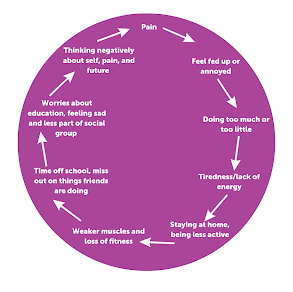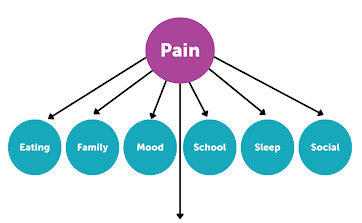Abdominal Pain Resource Pack
This pack is aimed at children and young people who have long lasting abdominal (tummy) pain. When a physical cause cannot be seen on a test or a scan, it is called ‘Functional pain’, because it affects your functioning (what you are able to do).
Most pain is like a warning, it is your body’s way of telling you that you are either hurt, or about to be hurt. This warning allows you to do something to prevent further pain. For example, when you touch something hot, the pain makes you move your hand to stop you burning yourself.
After you have injured yourself, e.g. if you break your leg, your brain can keep sending pain messages for a while, even when things have healed. The pain does not mean that your leg is still damaged.
So, sometimes pain sticks around longer than it needs to and sometimes there is no actual injury or problem causing the pain, but it is still definitely real. The usual medical treatment of pain relief does not work very well for this kind of pain. When this happens, the brain seems to be confused, sending pain messages when it doesn’t need to.
There is also information about this type of pain on our chronic abdominal pain page.
🖨 Printable version of this resource pack.
This pack has been produced with Frimley Health NHS Trust in partnership with Healthier Together.
How does your pain affect you?
Living with pain can be difficult. It can affect the things you do, it can also impact the way you feel and think, as well as your relationships with friends and family.
Have a look at the examples below of how pain can affect young people. Use the blank spaces to write other ways in which pain has affected your life.
For a printable version of this worksheet, click here.
Functional abdominal pain
What Is Functional Abdominal Pain?
Functional abdominal pain is a type of chronic pain, it is relatively common and reported in up to 18% of young people. It is a condition where children and young adults experience frequent periods of abdominal (tummy) pain over an extended period. Chronic means lasting more than a few weeks.
Functional means that there is no physical blockage, infection or inflammation causing the pain. Nevertheless, the pain is real and can be distressing for both children and adults. Like all pain, abdominal pain can affect your thoughts, feelings, and behaviour in many situations.
What Are The Symptoms Of Functional Abdominal Pain?
Children with functional abdominal pain often experience pain in the stomach or bowel area. They usually do not have any other signs of illness, such as a temperature, weight loss, or blood in their poo. Sometimes the pain may be associated with episodes of diarrhoea and constipation, or vomiting, but this is not the cause of the pain.
Functional abdominal pain is sometimes associated with other symptoms such as headaches, limb pain, and sleep disturbances.
What Causes Functional Abdominal Pain?
The exact cause of functional abdominal pain is largely unknown, although the condition has been studied a lot by researchers and medical professionals. Many practitioners agree that biological and psychological factors interact to maintain the pain; it is possible that pain is due to overly sensitive nerves in the gut. The gut has a massive network of nerves which send signals to the brain when we are hungry, full, or ill. This is called The Gut-Brain Axis. Sometimes these messages can be influenced by things outside the gut and misinterpreted by the brain. For example, it is common for children and young adults to not feel hungry on the morning of an exam. Others may need to vomit, or visit the toilet frequently.
The symptoms are real and are especially difficult to manage in stressful or anxiety-provoking situations, but it is important to remember that they are not caused by a physical disease.
The pain gate
The sensation of pain is affected by both physical and psychological processes. Signals from nerve endings in the nervous system passes through a neural ‘gate’ in the spinal cord before being passed to the brain. The ‘gate’ is what determines how much pain we feel. The more open the gate is, the more pain we feel. Factors that open the gate:
- Stress and Tension – All sorts of emotional states can lead to the gates to pain being more open. These include being anxious, worried, angry, and sad. Having a lot of tension in the body is a common way of opening the pain gates.
- Focusing on the pain – Pain can feel worse when we concentrate on it a lot.
- Lack of Activity – Not moving or and stopping our normal activities can make pain worse. It can also reduce our fitness levels.
The more closed the gate is, the less pain we feel. Factors that close the gate:
- Relaxation and Contentment – Feeling generally happy and optimistic has been found to help close the pain gate.
- Psychological Factors - Feeling relaxed and content, possibly by doing relaxation exercises (see worksheets following page 13), keeping your mind busy and distracted with other things, and focusing your attention on doing things that are important to you (rather than focusing on the pain and gloomy thoughts associated with it).
- Activity – Being active but not overdoing it so you develop your fitness (see ‘Pacing’ worksheet, page 9)
- Other Physical Factors – some types of counter-stimulation (heat, massage, and acupuncture) may help.
The pain cycle
Long term pain can create a cycle in which we feel trapped. The first step to breaking out of the pain cycle is to understand what it is! By understanding the pain cycle, we can start to see that there are several things that can be done to help manage your pain.

As you can see, pain can affect you in many ways. It affects your thoughts, feelings, body, and behaviour. Therefore medication does not work as well for chronic/long term pain, as it focuses on the physical symptoms. It is important to think about thoughts, feelings, and behaviours too as they all affect the experience of pain.
Changing how you cope with pain: Doing too much or too little
Pacing
Some people who suffer with long term abdominal pain choose to do less activity. This makes sense; however, it can result in you missing out on important and fun activities. However, we know that missing out can negatively impact your mood. Some people try to stay very active on days they feel better. Again, this approach makes sense but can be counterproductive. You may push yourself too hard and end up suffering, resulting in exhaustion and low mood. This is referred to as a boom-and-bust pattern
Pacing is a skill which enables you to consistently carry out activities without causing excessive tiredness or inactivity. Pacing is the middle ground between doing nothing and doing too much. Over time you may notice that pacing enables you to do more.
- Choose an activity, such as seeing your friends or school work.
- Measure the length of time you feel physically and emotionally comfortable doing this. Do this at least 3 separate times on good and bad days.
- Take the average of these times. This helps you find your comfortable starting point (amount of time) to spend on these activities. Try to stick to this time, no more and no less.
Remember:
- Pacing can give you more control.
- Pacing is about judging when to stop an activity based on time and not mood.
- The comfortable starting point should be used on both good, and bad days. It is normal to find it difficult to limit yourself on good days.
- Using a comfortable starting point leads to improved tolerance and achievement.
Planning future goals
1. Consider areas that you want to change or improve.
2. Try to set goals you are capable of achieving using determination. Do not underestimate your ability.
3. Have faith in yourself. Your thoughts can affect how you physically feel.
4. Write down your goals. It will help you to see what you have achieved.
5. Do not panic if you do not achieve your goal. Think about why. Perhaps you need to add in smaller step to achieve the long term goal?
6. Reward yourself when you achieve a goal.


Printable version of this worksheet.
Changing how you cope with abdominal pain
When we experience abdominal pain, we can often stop doing things that we used to enjoy. However, avoiding things often makes us feel worse in the long term.
- The first step is to think about things you have stopped doing/are doing less/are avoiding because of your abdominal pain. Make a note below of things you are avoiding because of how you are feeling.
Turn your phone landscape to view this table in full.
| Things around the home
|
|
| Things at work or school
|
|
| Hobbies and Interests
|
|
| Social Activities with Friends and Family:
|
|
| Anything else?
|
- Once you have filled in Section 1, the next step is to plan how easy it would be to start doing some of the avoided activities again. It may seem overwhelming in the beginning, however, it is much easier if you break the process down into smaller steps.
Create a ladder (hierarchy) of things you avoid with the ones you are most anxious about at the top, and the ones that bother you less at the bottom. Try to include a good mix of the things you wrote down in Section 1. Start to tackle your fears and your abdominal pain by starting at the bottom of the ladder and gradually working your way through each step. Before completing each task, write down what you think will happen, and follow this up by writing down what happened after task completion. Hopefully you will start to see that it is mostly not as bad as you think it is going to be.
Turn your phone landscape to view this table in full.
| Situation
|
Difficulty – 0 to 10
|
|
| Example: playing rugby again
|
10 (most difficult)
|
|
| Example: texting a friend
|
0 (least difficult)
|
Printable version of this exercise.
SMART goals
Having abdominal pain can cause you to stop taking part in activities you enjoy. Goal setting is about working out what you would like to be able to do, and working towards achieving it. Goal setting is a powerful way of improving your quality of life and sense of control. It is important that goals are meaningful to you and feel good.
A goal is something that you are motivated to work towards and achieve. When you are working on activity levels, it is important to set goals that can help to both motivate you, as well as direct your efforts and energy.
- Specific: clearly state what you would like to happen
- Measurable: will you be able to say it was achieved?
- Achievable: are you able to complete the task independently?
- Realistic: are you going to do it?
- Timely: think whether it is ‘the right time’ to do this. Set yourself a realistic time limit to achieve this goal.
Specific
To create a specific goal it must answer the 6 ‘W’s.
- WHO is this goal for/who is involved in it?
- WHAT is it that needs to be accomplished?
- WHERE should this goal take place?
- WHEN will this goal be completed, or how long will it take?
- WHICH things or requirements, and constraints, need to be identified?
- WHY does this goal need to be accomplished? What is its purpose?
For example:
‘I want to use Progressive Muscle Relaxation to help manage my pain’ as a SMART goal would be:
‘I want to use Progressive Muscle Relaxation 30 minutes, everyday at home for one month, to reduce my symptom severity’.
Measurable
Measurable goals make it easier to stay on track to meeting your goals. Questions like ‘how much’, or ‘how many’, or ‘how will I tell if I met my goal’ is a good way to determine what to measure. For example, practicing Progressive Muscle Relaxation for 30 minutes everyday is quantifiable and measurable. You can track your progress and see results.
Realistic
When you are coping with abdominal pain you need to have goals which are realistic and reasonable. It is easy to get ahead of yourself. Sometimes people fall into the trap of getting overwhelmed by goals which seem impossible. Make a realistic goal by breaking into smaller goals.
Timely
An important factor in achieving your goals is seeing the progress you have made. Set a time limit to complete your goal. For example, practice progressive muscle relaxation for 30 minutes each day, for a month before you tackle another goal. Write down your progress, seeing progress can motivate and encourage you.
Doing more
Mood can be greatly affected by what we do, when we do it, and with whom.
Keep track of what you do each day and make sure you are spending your time doing enough things that give you a sense of:
- A - achievement
- C – closeness to others
- E – enjoyment
Being mindful of these 3 things when goal setting may help you to set meaningful SMART goals. Doing more also allows less time for negative and unhelpful thoughts and overthinking, which will have a positive effect on mood.
Supporting children and teenagers experiencing functional abdominal pain
It can be difficult to see a child/teenager in pain. However, as an adult there are ways in which you can help improve their ability to cope with pain:
Reassurance. Although we do not know the exact organic cause of functional abdominal pain, your doctor will have completed tests to check that there are no other concerns. It is important to reassure your child that although their symptoms of pain are real (and you understand that they are not making them up), they are not dangerous.
Record. When you first notice pain, you may like to keep a pain diary. This may be helpful to learn about triggers and factors that make the pain better/worse. Please ask your doctor for a pain diary if you plan to see them again, and they think that this would be helpful.
Distract and reduce focus on pain. It can be difficult to know how to respond to a child/ young adult who is in pain. Often, the natural urge is to pay attention to signs that the young person may be in pain and to reassure them. It is important to avoid making the child/ young person worry or become anxious, as they may focus on their pain more. Although it is challenging as a parent, it is important to minimise attention on the pain, for example, by not asking how pain is. When pain starts, you may find it more beneficial to help the young person focus on something other than the pain, perhaps by engaging them in something they enjoy.
Encourage normal activities. It is important to not stop the young person doing the things they enjoy due to a fear of pain. You can reinforce ‘well behaviour’ (e.g. doing enjoyable activities) and give them confidence to resume their hobbies and interests, despite pain.
Provide encouragement. Children and young people will feel more confident in their ability to cope with their pain with your support and confidence. Your role is to provide positive encouragement that they can cope with and manage their pain.
Support. Pain may affect your child/teenager’s ability to complete homework, coursework, and revision. Offering support with studies may relieve some of the stress, in turn decreasing the chance of reoccurring pains. You may like to provide this information to their school/college so they can provide extra support where necessary.
Guided self help worksheets
Calming The Body
Feeling relaxed can help reduce symptom severity.
Progressive Muscle Relaxation (PMR)
Muscle tension is commonly associated with stress and anxiety, it is the body’s natural response to potentially dangerous situations. Even when there is no danger, our bodies can still respond in the same way. You may not always realise that your muscles are tense, it may be as subtle as your jaw clenching, or as obvious as your shoulders feeling tight and hunched. PGR is a deep relaxation technique which is based upon the simple practice of tensing one muscle group at a time . This is followed by a relaxation phase with release of tension. This is very useful before bedtime.
During deep breathing your blood is oxygenated, triggering the release of endorphins, whilst also decreasing the release of stress hormones, and slowing down your heart rate.
Calming The Mind
Strategies for managing the anxiety and stress that is often associated with abdominal pain.
Worry Trees are helpful in reducing levels of anxiety surrounding both hypothetical situations and current problems.
Help yourself to feel more relaxed by thinking about things that make you feel calm and rested. For example, picturing your favourite place. This can be either independent, or you can take a guided visualisation approach. A guided visual imagery relaxation task has been provided in this pack.
A powerful stress reduction and relaxation tool, that can be applied at any time, in any location.
This is a useful technique for remaining grounded in the present, to alleviate symptoms of stress and anxiety.
These are phrases that you can say to yourself that are supportive. For example “Just because it has happened before it does not mean it will happen again”
Online resources
Apps:
Smiling Mind Mindfulness and Sleep
Calm Meditation and Sleep
Headspace Meditation
Think Pacifica Progressive Muscle Relaxation
Other pain resources:
Pain Concern
The Pain Toolkit. This source lists a collection of useful resources for healthcare professionals, families of, and people living in pain
- The Retrain Pain Foundation has a good selection of short videos that are helpful in understanding pain
Great Ormond Street NHS Foundation Trust provides information on chronic pain
Other useful websites:
 Resources for Teachers, Parents, Carers, and Children. Don't want to talk? Text YM to 85258, the Young Minds Crisis Messenger for free 24 hours a day, 7 days a week support.
Resources for Teachers, Parents, Carers, and Children. Don't want to talk? Text YM to 85258, the Young Minds Crisis Messenger for free 24 hours a day, 7 days a week support.  Kooth is a free, safe, and anonymous online wellbeing community for young people. You can sign up without being referred by anyone and you don’t need to download any apps.
Kooth is a free, safe, and anonymous online wellbeing community for young people. You can sign up without being referred by anyone and you don’t need to download any apps.- Moodcafe.co.uk Stress and Anxiety
- Anxiety and Depression
- Getselfhelp.co.uk Mindful Activity
- Getselfhelp.co.uk Relaxing Imagery
- Getselfhelp.co.uk Thought Distancing
- Getselfhelp.co.uk Supporting Sleep
Local resources
West Yorkshire
West Yorkshire Night OWLS is available 8pm to 8am every day for children, young people, parents and carers across West Yorkshire. Call free on 0800 1488 244 or text on 07984 392700. Visit the website to use the online chat function www.wynightowls.org.uk
Kooth is an online counselling and emotional well being platform for children and young people. 10 to 18 year olds can chat one to one with counsellors, access self help articles and connect with peers through live moderated forums.
Bradford and Craven
Healthy Minds for young people is there to help you find support, information and advice if you are struggling with how you are feeling and thinking.
Wellbeing hubs provide support and free specialist advice on a number of areas including mental health. If you are under 16 you need to bring a parent or carer with you.
Leeds
MindMate was designed with young people to provide information about common mental health issues and where to find support.
Kirklees and Calderdale
Open Minds provides advice, information, support and signposting to local and national emotional health and wellbeing services.
Wakefield
WF I Can is an online resource for young people in Wakefield where you can find information and advice.



